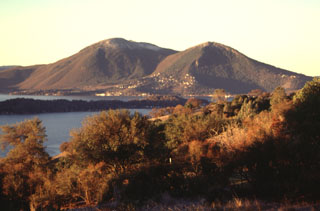Report on Clear Lake Volcanic Field (United States) — June 1992
Bulletin of the Global Volcanism Network, vol. 17, no. 6 (June 1992)
Managing Editor: Lindsay McClelland.
Clear Lake Volcanic Field (United States) 50 small seismic events triggered by M 7.5 earthquake hundreds of km away
Please cite this report as:
Global Volcanism Program, 1992. Report on Clear Lake Volcanic Field (United States) (McClelland, L., ed.). Bulletin of the Global Volcanism Network, 17:6. Smithsonian Institution. https://doi.org/10.5479/si.GVP.BGVN199206-323100
Clear Lake Volcanic Field
United States
38.97°N, 122.77°W; summit elev. 1439 m
All times are local (unless otherwise noted)
Southern California's largest earthquake since 1952, M 7.5 on 28 June, appeared to trigger seismicity at several volcanic centers in California. It was centered roughly 200 km E of Los Angeles. In the following, David Hill describes post-earthquake activity at Long Valley caldera, and Stephen Walter discusses the USGS's seismic network, and the changes it detected at Lassen, Shasta, Medicine Lake, and the Geysers.
In recent years, the USGS northern California seismic network has relied upon Real-Time Processors (RTPs) to detect, record, and locate earthquakes. However, a film recorder (develocorder) collects data from 18 stations in volcanic areas, primarily to detect long-period earthquakes missed by RTPs. The film recorders proved useful in counting the post-M 7.5 earthquakes, most of which were too small to trigger the RTPs.
The film record was scanned for the 24 hours after the M 7.5 earthquake, noting the average coda duration for each identified event. Some events may have been missed because of seismogram saturation by the M 7.5 earthquake. Marked increases in microseismicity were observed at Lassen Peak, Medicine Lake caldera, and the Geysers (table 1). No earthquakes were observed at Shasta, but the lack of operating stations on the volcano limited the capability to observe small events.
Table 1. Number of earthquakes at northern California volcanic centers during 24-hour periods following major earthquakes on 25 April (40.37°N, 124.32°W; M 7.0) and 28 June (34.18°N, 116.47°W; M 7.5) 1992. Events with coda durations less than or equal to 10 seconds and greater than 10 seconds are tallied separately. Earthquakes were identified from film records of seismograms from nearby stations. Courtesy of Stephen Walter.
| Volcanic center | Lassen | Lassen | Shasta | Shasta | Medicine Lake | Medicine Lake | Geysers | Geysers |
| Codas (seconds) | 0-10 | 11+ | 0-10 | 11+ | 0-10 | 11+ | 0-10 | 11+ |
| 25 Apr 1992 | 0 | 0 | 0 | 1 | 0 | 0 | 7 | 2 |
| 28 Jun 1992 | 8 | 14 | 1 | 5 | 12 | 0 | 46 | 4 |
Film was also scanned for the 24 hours following the M 7.0 earthquake at 40.37°N, 124.32°W (near Cape Mendocino) on 25 April. Although smaller than the 28 June earthquake, its epicenter was only 20-25% as far from the volcanoes. Furthermore, both the 25 April main shock and a M 6.5 aftershock were felt at the volcanic centers, but no felt reports were received from these areas after the 28 June earthquake. Only the Geysers showed any possible triggered events after the 25 April shock. However, background seismicity at the Geysers is higher than at the other centers, and is influenced by fluid injection and withdrawal associated with intensive geothermal development.
Geysers geothermal area report. Film records showed 50 small events in the 24 hours following the M 7.5 earthquake, 46 of which had coda durations
Geological Summary. The late-Pliocene to early Holocene Clear Lake Volcanic Field in the northern Coast Ranges contains lava dome complexes, cinder cones, and maars of basaltic-to-rhyolitic composition. The westernmost site of Quaternary volcanism in California, this volcanic field is in a complex geologic setting within the San Andreas transform fault system. Mount Konocti, a composite dacitic lava dome on the south shore of Clear Lake, is the largest volcanic feature. Volcanism has been largely non-explosive, with only one major airfall tuff. The latest eruptive activity, forming maars and cinder cones along the shores of Clear Lake, continued until about 9,000 years ago. A large silicic magma body provides the heat source for the Geysers, a geothermal field with a complex of electrical power plants.
Information Contacts: Stephen Walter and David Hill, MS 977, U.S. Geological Survey, 345 Middlefield Road, Menlo Park, California 94025 USA.

